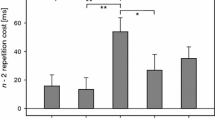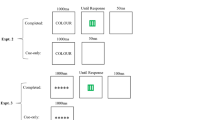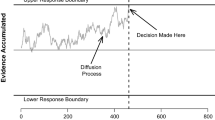Abstract
Task inhibition is considered to facilitate switching to a new task and is assumed to decay slowly over time. Hence, more persisting inhibition needs to be overcome when returning to a task after one intermediary trial (ABA task sequence) than when returning after two or more intermediary trials (CBA task sequence). Schuch and Grange (J Exp Psychol Learn Mem Cogn 41:760–767, 2015) put forward the hypothesis that there is higher task conflict in ABA than CBA sequences, leading to increased cognitive control in the subsequent trial. They provided evidence that performance is better in trials following ABA than following CBA task sequences. Here, this effect of the previous task sequence (“N-3 effect”) is further investigated by varying the cue–stimulus interval (CSI), allowing for short (100 ms) or long (900 ms) preparation time for the upcoming task. If increased cognitive control after ABA involves a better preparation for the upcoming task, the N-3 effect should be larger with long than short CSI. The results clearly show that this is not the case. In Experiment 1, the N-3 effect was smaller with long than short CSI; in Experiment 2, the N-3 effect was not affected by CSI. Diffusion model analysis confirmed previous results in the literature (regarding the effect of CSI and of the ABA–CBA difference); however, the N-3 effect was not unequivocally associated with any of the diffusion model parameters. In exploratory analysis, we also tested the alternative hypothesis that the N-3 effect involves more effective task shielding, which would be reflected in reduced congruency effects in trials following ABA, relative to trials following CBA; congruency effects did not differ between these conditions. Taken together, we can rule out two potential explanations of the N-3 effect: Neither is this effect due to enhanced task preparation, nor to more effective task shielding.








Similar content being viewed by others
Notes
We would like to thank an anonymous reviewer for pointing this out.
References
Astle, D. E., Jackson, G. M., & Swainson, R. (2012). Two measures of task-specific inhibition. The Quarterly Journal of Experimental Psychology, 65, 233–251.
Botvinick, M. M., Braver, T. S., Barch, D. M., Carter, C. S., & Cohen, J. D. (2001). Conflict monitoring and cognitive control. Psychological Review, 108, 624–652.
Bugg, J. M., & Braver, T. S. (2016). Proactive control of irrelevant task rules during cued task switching. Psychological Research Psychologische Forschung, 80, 860–876.
Duthoo, W., Abrahamse, E. L., Braem, S., Boehler, C. N., & Notebaert, W. (2014a). The heterogeneous world of congruency sequence effects: An update. Frontiers in Psychology, 5, 1001.
Duthoo, W., Abrahamse, E. L., Braem, S., Boehler, C. N., & Notebaert, W. (2014b). The congruency sequence effect 3.0: A critical test of conflict adaptation. PLoS One, 9(10), e110462.
Egner, T. (2007). Congruency sequence effects and cognitive control. Cognitive, Affective, and Behavioral Neuroscience, 7, 380–390.
Egner, T. (2017). Conflict adaptation: Past, present, and future of the congruency sequence effect as an index of cognitive control. In T. Egner (Ed.), The Wiley handbook of cognitive control (pp. 64–78). Oxford: Wiley-Blackwell.
Faul, F., Erdfelder, E., Lang, A.-G., & Buchner, A. (2007). G*Power 3: A flexible statistical power analysis program for the social, behavioral, and biomedical sciences. Behavior Research Methods, 39, 175–191.
Fischer, R., Gottschalk, C., & Dreisbach, G. (2014). Context-sensitive adjustment of cognitive control in dual-task performance. Journal of Experimental Psychology: Learning, Memory, and Cognition, 40, 399–416.
Fischer, R., & Hommel, B. (2012). Deep thinking increases task-set shielding and reduces shifting flexibility in dual-task performance. Cognition, 123, 303–307.
Gade, M., Schuch, S., Druey, M., & Koch, I. (2014). Inhibitory control in task switching. In J. A. Grange & G. Houghton (Eds.), Task switching and cognitive control (pp. 137–159). New York: Oxford University Press.
Goschke, T. (2000). Intentional reconfiguration and involuntary persistence in task set switching. In S. Monsell & J. Driver (Eds.), Control of cognitive processes: Attention and performance XVIII (pp. 331–355). Cambridge, MA: MIT Press.
Goschke, T. (2013). Volition in action: Intentions, control dilemmas and the dynamic regulation of cognitive intentional control. In W. Prinz, A. Beisert & A. Herwig (Eds.), Action science: Foundations of an emerging discipline (pp. 409–434). Cambridge, MA: MIT Press.
Goschke, T., & Bolte, A. (2014). Emotional modulation of control dilemmas: The role of positive affect, reward, and dopamine in cognitive stability and flexibility. Neuropsychologia, 62, 403–423.
Grange, J. A., & Houghton, G. (2014). Task switching and cognitive control—an introduction. In J. A. Grange & G. Houghton (Eds.), Task switching and cognitive control (pp. 1–26). New York: Oxford University Press.
Karayanidis, F., Mansfield, E. L., Galloway, K. L., Smith, J. L., Provost, A., & Heathcote, A. (2009). Anticipatory reconfiguration elicited by fully and partially informative cues that validly predict a switch in task. Cognitive, Affective and Behavioral Neuroscience, 9, 202–215.
Katzir, M., Ori, B., & Meiran, N. (2018). “Optimal suppression” as a solution to the paradoxical cost of multitasking: Examination of suppression specificity in task switching. Psychological Research Psychologische Forschung, 82, 24–39.
Kiesel, A., Steinhauser, M., Wendt, M., Falkenstein, M., Jost, K., Philipp, A. M., & Koch, I. (2010). Control and interference in task switching—a review. Psychological Bulletin, 136, 849–874.
Koch, I., Gade, M., Schuch, S., & Philipp, A. M. (2010). The role of inhibition in task switching—a review. Psychonomic Bulletin and Review, 17, 1–14.
Koch, I., Poljac, E., Müller, H., & Kiesel, A. (2018). Cognitive structure, flexibility, and plasticity in human multitasking–an integrative review of dual-task and task-switching research. Psychological Bulletin, 144, 557–583.
Longman, C. S., Lavric, A., Munteanu, C., & Monsell, S. (2014). Attentional inertia and delayed orienting of spatial attention in task-switching. Journal of Experimental Psychology: Human Perception and Performance, 40, 1580–1602.
Madden, D. J., Spaniol, J., Costello, M. C., Bucur, B., White, L. E., Cabeza, R., Davis, S. W., Dennis, N. A., Provenzale, J. M., & Huettel, S. A. (2009). Cerebral white matter integrity mediates adult age differences in cognitive performance. Journal of Cognitive Neuroscience, 21, 289–302.
Mayr, U. (2007). Inhibition of task sets. In D. S. Gorfein & C. M. MacLeod (Eds.), Inhibition in cognition (pp. 27–44). Washington D.C.: American Psychological Association.
Mayr, U., & Keele, S. W. (2000). Changing internal constraints on action: The role of backward inhibition. Journal of Experimental Psychology: General, 129, 4–26.
Meiran, N. (2000). Modeling cognitive control in task-switching. Psychological Research Psychologische Forschung, 63, 234–249.
Meiran, N., Hsieh, S., & Dimov, E. (2010). Resolving task rule incongruence during task switching by competitor rule suppression. Journal of Experimental Psychology: Learning, Memory, and Cognition, 36, 992–1002.
Ratcliff, R., & McKoon, G. (2008). The diffusion decision model: Theory and data for two-choice decision tasks. Neural Computation, 20, 873–922.
Ratcliff, R., Smith, P. L., Brown, S. D., & McKoon, G. (2016). Diffusion decision model: Current issues and history. Trends in Cognitive Sciences, 20, 260–281.
Rogers, R. D., & Monsell, S. (1995). Costs of a predictable switch between simple cognitive tasks. Journal of Experimental Psychology: General, 124, 207–231.
Scheil, J., & Kleinsorge, T. (2014). N-2 repetition costs depend on preparation in trials n-1 and n-2. Journal of Experimental Psychology: Learning, Memory, and Cognition, 40, 865–872.
Schmiedek, F., Oberauer, K., Wilhelm, O., Süss, H. M., & Wittmann, W. W. (2007). Individual differences in components of reaction time distributions and their relations to working memory and intelligence. Journal of Experimental Psychology: General, 136, 414–429.
Schmitz, F., & Voss, A. (2012). Decomposing task-switching costs with the diffusion model. Journal of Experimental Psychology: Human Perception and Performance, 38, 222–250.
Schmitz, F., & Voss, A. (2014). Components of task switching: A closer look at task switching and cue switching. Acta Psychologica, 151, 184–196.
Schneider, D. W. (2014). Modeling graded response congruency effects in task switching. Acta Psychologica, 153, 160–168.
Schuch, S., & Koch, I. (2003). The role of response selection for inhibition of task sets in task shifting. Journal of Experimental Psychology: Human Perception and Performance, 29, 92–105.
Schuch, S. (2016). Task inhibition and response inhibition in older versus younger adults: A diffusion model analysis. Frontiers in Psychology, 7, 1722.
Schuch, S., & Grange, J. A. (2015). The effect of N-3 on N-2 repetition costs in task switching. Journal of Experimental Psychology: Learning, Memory, and Cognition, 41, 760–767.
Schuch, S., & Konrad, K. (2017). Investigating task inhibition in children versus adults: A diffusion model analysis. Journal of Experimental Child Psychology, 156, 143–167.
Schuch, S., Werheid, K., & Koch, I. (2012). Flexible and inflexible task sets: Asymmetric interference when switching between emotional expression, sex, and age classification of perceived faces. The Quarterly Journal of Experimental Psychology, 65, 994–1005.
Sudevan, P., & Taylor, D. A. (1987). The cueing and priming of cognitive operations. Journal of Experimental Psychology: Human Perception and Performance, 13, 89–103.
Voss, A., & Voss, J. (2007). Fast-dm: A free program for efficient diffusion model analysis. Behavior Research Methods, 39, 767–775.
Voss, A., Voss, J., & Lerche, V. (2015). Assessing cognitive processes with diffusion model analysis: A tutorial based on fast-dm-30. Frontiers in Psychology, 6, 336.
Acknowledgements
This research/Stefanie Schuch was supported by a Grant within the Priority Program, SPP 1772 from the German Research Foundation (Deutsche Forschungsgemeinschaft, DFG), Grant No. SCHU 3046/1-1.
Author information
Authors and Affiliations
Corresponding author
Electronic supplementary material
Below is the link to the electronic supplementary material.
Rights and permissions
About this article
Cite this article
Schuch, S., Grange, J.A. Increased cognitive control after task conflict? Investigating the N-3 effect in task switching. Psychological Research 83, 1703–1721 (2019). https://doi.org/10.1007/s00426-018-1025-4
Received:
Accepted:
Published:
Issue Date:
DOI: https://doi.org/10.1007/s00426-018-1025-4




